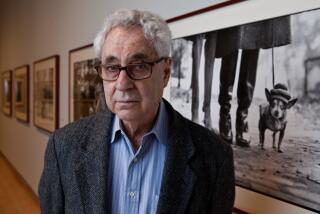Roman Vishniac; Famed Photographer
- Share via
Roman Vishniac, who as a young scientist in Eastern Europe produced a poignantly powerful series of photographs that recorded the faces of fellow Jews approaching their doom, is dead.
The zoologist and biologist, who later in his life concentrated on the minute life seen only through a microscope, was 92 when he died Monday in his New York City apartment of the complications of colon cancer.
In 1935, Vishniac, who held a doctorate in zoology, embarked on a 5,000-mile, three-year odyssey that took him through the terror-stricken ghettos of Eastern Europe, photographing the ravaged and haunted faces of a people that were unknowingly about to disappear in the Nazi slaughters of World War II.
“He used to say he took Hitler seriously and therefore he took the pictures,” said a relative, Jesse Cherry. “Everything he photographed was subsequently destroyed.”
Born in Russia, Vishniac turned from medical science photography to the eyes of undernourished children, of bearded patriarchs, of families in tattered clothing buying an occasional apple to supplement their meager daily fare.
What remained of his collection after he fled to the United States in 1940 was ultimately displayed in art museums and libraries around the world and praised not only for the tragedy it mirrored but for the starkness and lighting of his presentations.
Vishniac first became interested in both science and photography as a boy when he photographed a cockroach’s leg through a microscope.
After he moved to Berlin in the 1920s he had to pose as a Nazi, for any Jew with a camera was suspect.
After fleeing Germany he was interned briefly in a Vichy concentration camp in France but managed to obtain visas and escaped to New York City.
He was unable to speak English but still eked out a living as a portrait photographer before launching yet another career as a microphotographer. He won prizes for pictures that ranged from insects to frost on a leaf.
In 1971, the International Fund for Concerned Photography mounted an exhibition of Vishniac’s photographs that also included his scientific work, such as polarized light shots of microscopic creatures.
In an introduction to the exhibition, the photographer Edward Steichen wrote: “Roman Vishniac came back from his trips to Eastern Europe in the 1930s with a collection of photographs that has become an important historical document, for it gives a last-minute look at the human beings he photographed just before the fury of Nazi brutality exterminated them. The resulting photographs are among photography’s finest documents of a time and place.”
Vishniac’s works are included in the permanent collections of the Museum of Modern Art in New York, the Smithsonian Institution and the Library of Congress in Washington and the Jewish Museum in New York.
Another book of photographs of Jewish life is still to be published, said his daughter, Mara Kohn of Santa Barbara.
He also is survived by his wife, Edith, four grandchildren and five great-grandchildren.
A spokesman for the Simon Wiesenthal Center in Los Angeles said in a statement: “He was a visionary who understood that what his lens captured in pre-World War II Poland would be the last images of a vanished world. His photographs captured the life and soul of a people.”
More to Read
The biggest entertainment stories
Get our big stories about Hollywood, film, television, music, arts, culture and more right in your inbox as soon as they publish.
You may occasionally receive promotional content from the Los Angeles Times.










